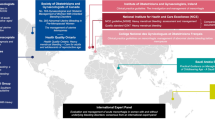Abstract
Objectives
To assess the efficacy and safety of dual oral iron chelation therapy (deferiprone and deferasirox) in decreasing iron overload status, using serum ferritin and liver and cardiac MRI as indicators, in transfusion dependent thalassemic children.
Methods
This was a prospective observational study conducted in a tertiary care hospital for a period of one year. Children with thalassemia between 2 and 18 y of age with serum ferritin above 1500 ng/ml were started on oral deferiprone and deferasirox. They were followed up for one year. Serum ferritin and MRI quantification of liver and cardiac iron concentration was done at enrolment and end of 12 mo. They were also monitored monthly for any adverse effects.
Results
Twenty one thalassemic children with mean age of 7.8 y (range 4–12 y) and a mean ferritin value of 3129 + 1231.5 ng/ml were enrolled. Mean serum ferritin decreased by 1226.3 ng/ml (p = 0.047, 95% CI =10.2, 1504.3) with 16.8% fall from baseline. The reduction in ferritin correlated significantly with the initial ferritin level (spearman’s rho = 0.742, p = 0.001). Mean liver iron concentration and myocardial iron concentration did not change significantly. Red color urine, transient rise in creatinine and liver enzymes were noted during the study period.
Conclusions
Combined oral chelation with deferiprone and deferasirox significantly decreases the serum ferritin level in children with severe iron overload. The drugs were tolerated well without any serious adverse effects.
Similar content being viewed by others
References
Gomber S, Jain P, Sharma S, Narang M. Comparative efficacy and safety of oral iron chelators and their novel combination in children with thalassemia. Indian Pediatr. 2016;53:207–10.
Elalfy MS, Adly AM, Wali Y, Tony S, Samir A, Elhenawy YI. Efficacy and safety of a novel combination of two oral chelators deferasirox/deferiprone over deferoxamine/deferiprone in severely iron overloaded young beta thalassemia major patients. Eur J Haematol. 2015;95:411–20.
Garbowski MW, Carpenter J-P, Smith G, et al. Biopsy-based calibration of T2* magnetic resonance for estimation of liver iron concentration and comparison with R2 Ferriscan. J Cardiovasc Magn Reson. 2014;16:40.
Carpenter J-P, He T, Kirk P, et al. On T2* magnetic resonance and cardiac iron. Circulation. 2011;123:1519–28.
Totadri S, Bansal D, Bhatia P, Attri SV, Trehan A, Marwaha RK. The deferiprone and deferasirox combination is efficacious in iron overloaded patients with β-thalassemia major: a prospective, single center, open-label study. Pediatr Blood Cancer. 2015;62:1592–6.
Parakh N, Chandra J, Sharma S, Dhingra B, Jain R, Mahto D. Efficacy and safety of combined oral chelation with deferiprone and deferasirox in children with β-thalassemia major: an experience from North India. J Pediatr Hematol Oncol. 2017;39:209–13.
Hammond J, Thompson AA, Fogel MA, Hammond K, Kokroko J, Kwiatkowski JL. Combination oral chelation in adult patients with transfusion-dependent thalassemia and high iron burden. J Pediatr Hematol Oncol. 2019;41:e47–50.
Karami H, Kosaryan M, Amree AH, Darvishi-Khezri H, Mousavi M. Combination iron chelation therapy with deferiprone and deferasirox in iron-overloaded patients with transfusion-dependent β-thalassemia major. Clin Pract. 2017;7:912.
Quinn CT, Johnson VL, Kim H-Y, et al. Renal dysfunction in patients with thalassaemia. Br J Haematol. 2011;153:111–7.
Link G, Konijn AM, Breuer W, Cabantchik ZI, Hershko C. Exploring the “iron shuttle” hypothesis in chelation therapy: effects of combined deferoxamine and deferiprone treatment in hypertransfused rats with labeled iron stores and in iron-loaded rat heart cells in culture. J Lab Clin Med. 2001;138:130–8.
Wood JC. Guidelines for quantifying iron overload. Hematology Am Soc Hematol Educ Program. 2014;2014:210–5.
Wahidiyat PA, Wijaya E, Soedjatmiko S, Timan IS, Berdoukas V, Yosia M. Urinary iron excretion for evaluating iron chelation efficacy in children with thalassemia major. Blood Cells Mol Dis. 2019;77:67–71.
Siri-Angkul N, Chattipakorn SC, Chattipakorn N. Diagnosis and treatment of cardiac iron overload in transfusion-dependent thalassemia patients. Expert Rev Hematol. 2018;11:471–9.
Eghbali A, Taherahmadi H, Shahbazi M, Bagheri B, Ebrahimi L. Association between serum ferritin level, cardiac and hepatic T2-star MRI in patients with major β-thalassemia. Iran J Pediatr Hematol Oncol. 2014;4:17–21.
Belmont A, Kwiatkowski JL. Deferiprone for the treatment of transfusional iron overload in thalassemia. Expert Rev Hematol. 2017;10:493–503.
Pennell D, Porter JB, Cappellini MD, et al. Efficacy and safety of deferasirox (Exjade®) in reducing cardiac iron in patients with β-thalassemia major: results from the cardiac substudy of the EPIC trial. Blood. 2008;112:3873.
Viprakasit V, Nuchprayoon I, Chuansumrit A, et al. Deferiprone (GPO-L-ONE(®)) monotherapy reduces iron overload in transfusion-dependent thalassemias: 1-year results from a multicenter prospective, single arm, open label, dose escalating phase III pediatric study (GPO-L-ONE; A001) from Thailand. Am J Hematol. 2013;88:251–60.
Origa R, Piga A, Tartaglione I, et al. Renal safety after more than a decade of deferasirox use in patients with transfusional hemosiderosis. Blood. 2016;128:2466.
Sarbay H, Kara MA. Proteinuria due to increased dose of deferasirox in a pediatric patient with thalassemia major: case report. Int J Contemp Pediatr. 2018;5:2338–40.
Author information
Authors and Affiliations
Contributions
CGDK and RRDJ: Conceptualized the study. RRDJ: Collected the data and drafted the initial manuscript. CGDK and GRK: Analysis of data and literature search; GRK: Intellectual input in final drafting and overall supervision. All authors contributed to the critical revision of the article. Dr. Niranjan Biswal is the Guarantor for this paper.
Corresponding author
Ethics declarations
Ethics Committee Approval
Ethics Committee approval was obtained for the study from JIPMER, Institute Ethics committee (Human studies) (JIP/IEC/2017/0292).
Conflict of Interest
None.
Informed Consent
Detailed information about the study was given to the subjects who accepted to participate in the study as well as to their parents and they were asked to sign an informed consent form.
Additional information
Publisher’s Note
Springer Nature remains neutral with regard to jurisdictional claims in published maps and institutional affiliations.
Rights and permissions
About this article
Cite this article
DivakarJose, R.R., Delhikumar, C.G. & Ram Kumar, G. Efficacy and Safety of Combined Oral Chelation with Deferiprone and Deferasirox on Iron Overload in Transfusion Dependent Children with Thalassemia – A Prospective Observational Study. Indian J Pediatr 88, 330–335 (2021). https://doi.org/10.1007/s12098-020-03442-5
Received:
Accepted:
Published:
Issue Date:
DOI: https://doi.org/10.1007/s12098-020-03442-5




